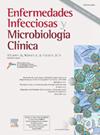Effectiveness of immunization strategies for preventing severe acute respiratory infection during the 2023/2024 season in a Spanish health department
IF 2.5
4区 医学
Q3 INFECTIOUS DISEASES
Enfermedades infecciosas y microbiologia clinica
Pub Date : 2025-08-01
DOI:10.1016/j.eimc.2025.03.006
引用次数: 0
Abstract
Introduction
A public funded immunization program targeting influenza, COVID-19 and respiratory syncytial virus (RSV), was introduced in Spain for the 2023/2024 season. Effective immunization strategies depend on product coverage and effectiveness.
Objectives
Estimate of the impact of three severe acute respiratory infections (SARI) immunization strategies, during the 2023/2024 respiratory illness season in a Spanish health department.
Methods
We conducted an ecological study to compare cumulative hospitalization rates of SARI between the 2022/2023 and 2023/2024 seasons. Subsequently, a cross-sectional study was conducted to describe immunization coverage. Three observational test-negative case–control studies were carried out to evaluate the vaccine effectiveness (VE) against influenza and COVID-19 and the effectiveness of immunization with nirsevimab.
Results
During the 2023/2024 season 2952 patients were hospitalized due to SARI, representing hospitalization rates of 322.6/100,000 inhabitants (RR = 0.78), indicating a 21.8% (CI: 14.8–28.1) overall effectiveness of the immunization strategies (EIS) against SARI. The global EIS for influenza was 26.7% (CI: 15.2–36.7), with 5.9% (CI: −10.1–19.5) for influenza A and 94.0% (CI: 86.4–97.4) for influenza B. For COVID-19, the EIS was 19.3% (CI: 7.2–29.3). The EIS for RSV was 52.5% (CI: 35.4–65.0) in children <1 year-old. For the 2023/2024 season, influenza vaccination in those aged >64 decreased 7.9%, while COVID-19 vaccination fell by 40.6% in individuals >60 years. Nirsevimab reached high coverage of 94.78%. The aVE was 28.2% (CI: 4.7–45.9) for influenza and 29.2% (CI: 7.1–46.0) for COVID-19. The overall adjusted effectiveness of nirsevimab was 63.8% (CI: 9.6–85.5).
Conclusion
The observed EIS was likely due to RSV immunization in infants’ high coverage with good effectiveness and low influenza B circulation.
西班牙卫生部门2023/2024年季节预防严重急性呼吸道感染免疫战略的有效性
西班牙在2023/2024年流感、COVID-19和呼吸道合胞病毒(RSV)季节推出了一项公共资助的免疫规划。有效的免疫战略取决于产品的覆盖率和有效性。目的评估西班牙某卫生部门2023/2024年呼吸道疾病季节期间三种严重急性呼吸道感染(SARI)免疫策略的影响。方法通过生态学研究比较2022/2023和2023/2024季节SARI的累计住院率。随后,进行了一项横断面研究来描述免疫接种覆盖率。开展了3项观察性试验阴性病例对照研究,以评估流感和COVID-19疫苗的有效性(VE)以及尼瑟维单抗免疫的有效性。结果2023/2024年期间,2952例患者因急性呼吸道感染住院,住院率为322.6/10万(RR = 0.78),表明免疫策略(EIS)对急性呼吸道感染的总体有效性为21.8% (CI: 14.8 ~ 28.1)。流感的全球EIS为26.7% (CI: 15.2-36.7),甲型流感为5.9% (CI:−10.1-19.5),乙型流感为94.0% (CI: 86.4-97.4)。COVID-19的EIS为19.3% (CI: 7.2-29.3)。1岁儿童RSV的EIS为52.5% (CI: 35.4-65.0)。在2023/2024年流感季,64岁人群的流感疫苗接种率下降了7.9%,而60岁人群的COVID-19疫苗接种率下降了40.6%。Nirsevimab的覆盖率高达94.78%。流感的aVE为28.2% (CI: 4.7-45.9), COVID-19的aVE为29.2% (CI: 7.1-46.0)。nirsevimab的总调整有效性为63.8% (CI: 9.6-85.5)。结论婴儿呼吸道合胞病毒免疫覆盖率高,接种效果好,乙型流感流行率低。
本文章由计算机程序翻译,如有差异,请以英文原文为准。
求助全文
约1分钟内获得全文
求助全文
来源期刊
CiteScore
2.10
自引率
8.00%
发文量
194
审稿时长
29 days
期刊介绍:
Hoy está universalmente reconocida la renovada y creciente importancia de la patología infecciosa: aparición de nuevos agentes patógenos, de cepas resistentes, de procesos con expresión clínica hasta ahora desconocida, de cuadros de una gran complejidad. Paralelamente, la Microbiología y la Infectología Clínicas han experimentado un gran desarrollo como respuesta al reto planteado por la actual patología infecciosa. Enfermedades Infecciosas y Microbiología Clínica es la Publicación Oficial de la Sociedad Española SEIMC. Cumple con la garantía científica de esta Sociedad, la doble función de difundir trabajos de investigación, tanto clínicos como microbiológicos, referidos a la patología infecciosa, y contribuye a la formación continuada de los interesados en aquella patología mediante artículos orientados a ese fin y elaborados por autores de la mayor calificación invitados por la revista.

 求助内容:
求助内容: 应助结果提醒方式:
应助结果提醒方式:


